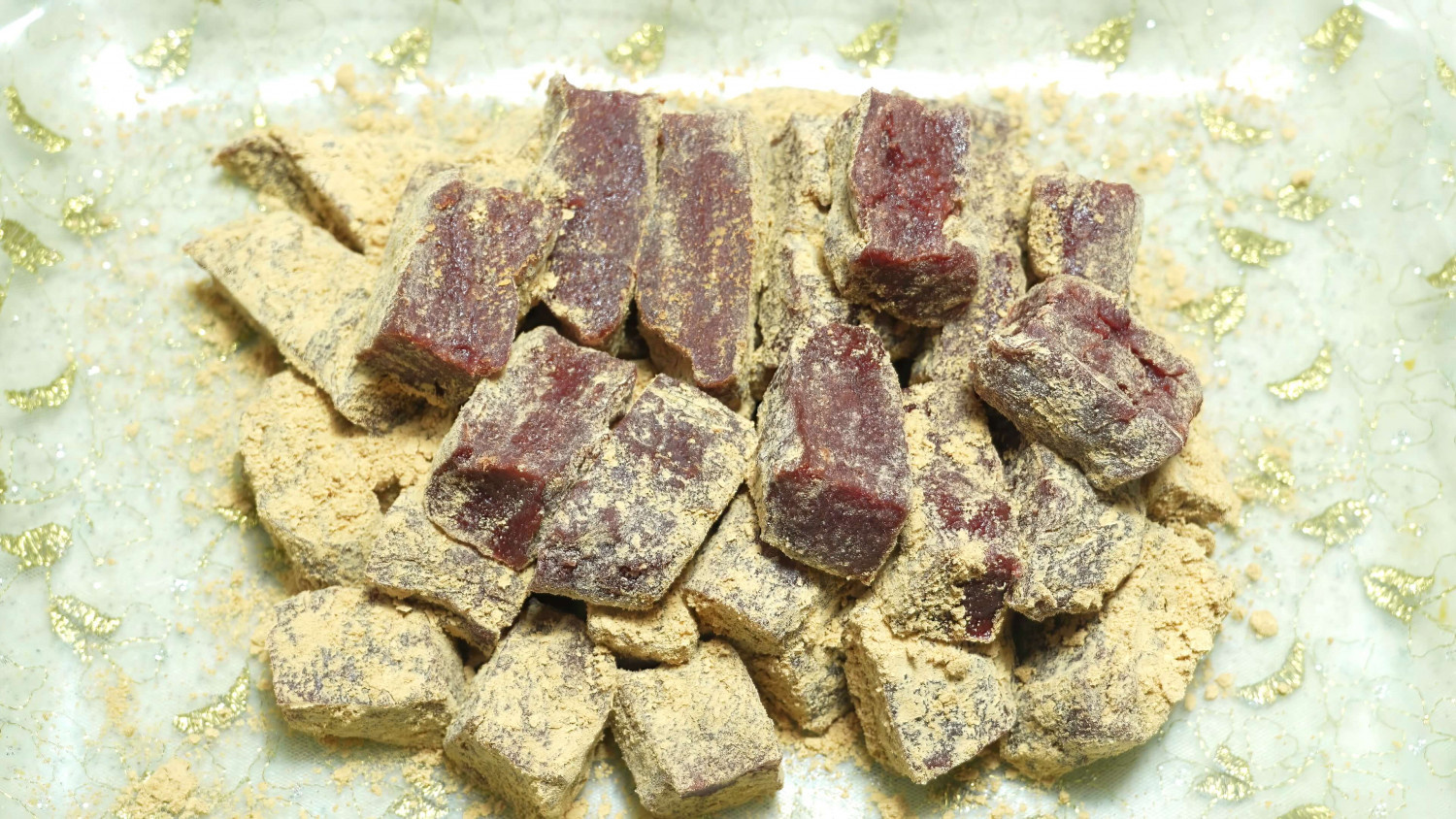Beetroot Mochi (Injeolmi)
How to Make Delicious Beetroot Mochi at Home, Minimizing the Beetroot Flavor and Enhancing Chewiness

If you’ve been looking for a way to enjoy the health benefits of beetroot beyond just pickles or juice, try making beetroot mochi! This recipe shows you how to easily create chewy, flavorful beetroot mochi at home by effectively removing excess moisture and the distinctive earthy flavor of beetroot. Beetroot naturally contains a lot of moisture, which contributes to a wonderfully chewy texture in mochi that doesn’t get tiresome. Once made, it stays delicious for a long time, so it’s worth preparing! We highly recommend making it in batches you’ll enjoy frequently.
Beetroot Mochi Ingredients- 1kg Sweet Rice Flour (Glutinous Rice Flour)
- 300g Dried Beetroot Powder (made from 2kg fresh beetroot)
- 1/2 Tbsp Coarse Sea Salt (approx. 7.5g)
- 200g Sugar (adjust to taste)
- 100ml Water (for dough consistency)
- 400g Roasted Soybean Flour (for coating)
Cooking Instructions
Step 1
① Prepare Beetroot: First, thoroughly clean 2kg of fresh beetroots. Peel them thinly using a vegetable peeler, then rinse them well under running water. Place the peeled beetroots in a steamer basket over boiling water, cover, and steam for about 25 minutes until tender. Once steamed, let them cool slightly. Then, spread the beetroots on dehydrator trays and dry them in a food dehydrator at 70°C (158°F) for 17 hours until completely crisp. If you don’t have a dehydrator, you can air-dry them in a sunny spot for 3-4 days. Once dried, grind the beetroots into a fine powder. This drying process is crucial to prevent the mochi from becoming mushy and to achieve a chewy texture, while also eliminating any earthy beetroot flavor.

Step 2
② Make Sweet Rice Flour Dough: Rinse 1kg of sweet rice flour (glutinous rice flour) 3-4 times under cold water until the water runs clear. Soak the rinsed rice in water for 3 to 4 hours to allow it to fully hydrate. After soaking, rinse the rice again and drain it thoroughly in a fine-mesh sieve. Place the drained 1kg of sweet rice flour and 1/2 tablespoon of coarse sea salt (approx. 7.5g) into a blender or food processor and grind it into a fine powder. (Tip: Add the salt only once during the grinding process to avoid making the dough too salty. Avoid adding salt multiple times.) Sift the ground sweet rice flour through a fine-mesh sieve, preferably twice, to ensure it’s extra fine. This step significantly contributes to the mochi’s chewy texture. If you notice any clumps in the flour, gently break them apart with your fingers. Ensuring there are no lumps is vital for achieving the best mochi texture.

Step 3
③ Combine Sweet Rice Flour and Beetroot Powder: To the sifted sweet rice flour, add 100g of sugar (about half a cup). Mix well. You can add the remaining 100g of sugar later after tasting. Sugar not only sweetens the mochi but also acts as a natural preservative, helping it last longer. Add 200g of the prepared dried beetroot powder (about one cup) to the sweet rice flour mixture and gently combine. If any clumps form due to the moisture in the sweet rice flour, gently rub them with your fingers to break them apart. Gradually add the remaining 100g of beetroot powder (about half a cup), ensuring a total of 300g of beetroot powder is incorporated. Mix everything together, taste, and add the remaining 100g of sugar (about half a cup) if you prefer it sweeter. Since the dried beetroot powder lacks moisture, pour in 100ml of water (about half a cup) and mix until all ingredients form a cohesive dough. While plain sweet rice mochi doesn’t require added water, the dried beetroot necessitates it for proper consistency. The dough is ready when it holds together when squeezed firmly in your hand.

Step 4
④ Steam and Finish the Beetroot Mochi: Line a steamer basket with a damp cheesecloth, ensuring it lies flat. Spread the beetroot sweet rice dough thinly and evenly over the cheesecloth. Spreading it thinly helps it cook evenly and achieve the perfect chewy texture. Steam the dough for 25 minutes. While the mochi is steaming, sprinkle 200g of roasted soybean flour (about one cup) onto a sieve or tray. This prevents the steamed mochi from sticking to the cheesecloth when you transfer it. Once steamed, carefully remove the mochi from the steamer and place it on the prepared soybean flour. Use a mallet or a sturdy spatula to gently pound the mochi several times. This pounding action further enhances its chewy and glutinous texture. Carefully peel off the cheesecloth while the mochi is still warm. (Tip: Using a bench scraper can make removing the cheesecloth easier.) After removing the cheesecloth, let the dough cool slightly. Once slightly cooled, sprinkle more soybean flour over the dough to prevent sticking. Shape the mochi into your desired form. For clean cuts, you can use a mold, or simply cut it into bite-sized pieces once it has cooled down a bit. If the knife sticks, dust it lightly with soybean flour. If you don’t have soybean flour, roasted barley flour (misugaru) or ground almond flour can be used as a substitute; almond flour offers a richer, nuttier flavor.




